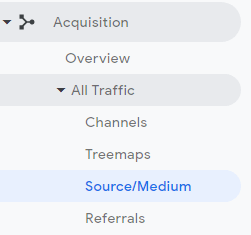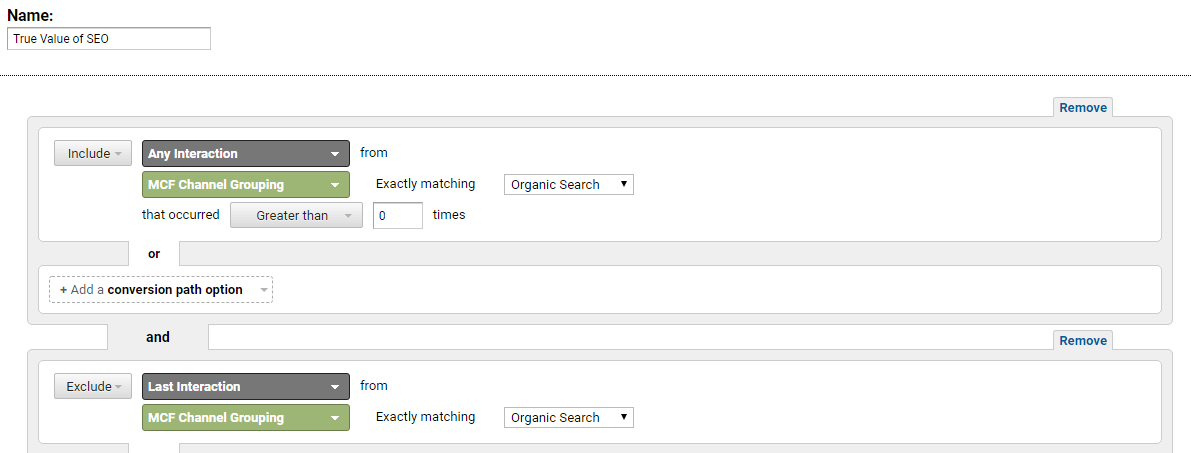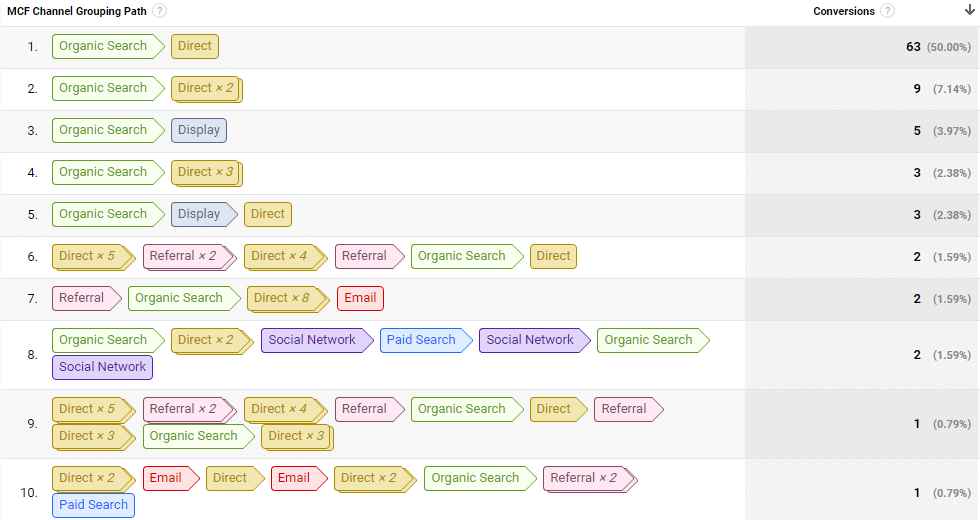
A simple method for multi-channel attribution in Google Analytics
Multi-channel attribution with Google Analytics has been a hot topic of chief marketing officers for a while.
If you’re not familiar, the basic dilemma is deciding what sources should get credit for the sale or lead in the customer journey. It’s not as simple as crediting wherever someone came from last (such as Facebook or Google ads), a method known as last-click attribution. That’s because a real customer journey has multiple data sources—indeed, we sometimes need multiple touchpoints to convince a prospect to buy.
Unfortunately, there are barely any articles that offer accurate, understandable digital marketing attribution models. If you search online, you’ll find articles that are convoluted, complex, and referencing various attribution models. That can make it difficult to make sense of the data or dedicate the time to set up and maintain reporting.
Not all hope is lost—I have a simple multi-channel attribution model that gives you an accurate report. My colleague EJ White introduced me to this feature. Using this approach, we’ve been able to credit a channel for up to 30% of sales for a business. That channel wouldn’t have gotten credit with the traditional last-click method.
Before I discuss this process, let’s touch on some of the issues with last-click attribution, an approach that many marketers default to because it’s the simplest out there.
The problem with traditional last-click attribution modeling in marketing
As its name implies, last-click attribution gives all the credit for a sale or lead to the last channel from which a customer came. Let’s say that person clicked on a Google ad and converted—all the credit goes to that particular Google ad.
You can obtain last-click attribution reporting in Google Analytics by clicking Attribution in the left sidebar, then All Traffic, and then Source/Medium.

From here, you can narrow in on any segment for that specific type of traffic. For example, you can apply the Organic segment to see which channels drive the most organic sales. Make sure a relevant goal is set up and selected under the Conversions drop-down on the right so you can see the quantity of Conversions (whether that’s a sale or a lead).
Some people choose to ignore direct traffic when creating a report on multi-touch attribution. We recommend crediting most direct traffic as organic traffic because research shows that’s true, and people can search and find your website and then return on their own without going through a search engine.
As you can already see, the customer journey starts to get more complicated than a simple last-click approach. A portion of that direct traffic could have very well seen your advertisements or heard about you through word of mouth and then decided to visit your site, but they’d end up getting classified as direct traffic.
The upside to this model is that it makes it easy to set up reporting, and it’s often set by default. People don’t need much convincing or lots of touchpoints for a high-impulse, low-cost product.
The downside is that it’s not accurate. There is no multi-channel attribution analysis since one channel gets all the credit. In reality, many people hear about a brand or product from multiple angles before they’re interested. Even before the Internet, someone may have heard about a product from a friend, a commercial, and a billboard before they recognized it enough to consider purchasing it. In a real customer journey today, a prospect can stumble across an organic Facebook post, a booth at a trade show, and a Google ad before they look up your Google or Yelp reviews and make a decision.
In fact, last-click attribution can be downright terrible. The truth is that many marketing efforts—whether SEO or Facebook ads—don’t get a lot of the credit they deserve because the real work was done much earlier, before the conversion. The danger of not being able to report on multi-touch is that an entire department can be fired if they can’t prove their worth, which sometimes relies on non-last-click contribution. We’ve personally seen an agency fired for this exact situation for their SEO services. Understanding the reporting issue, we were able to map out how SEO efforts doubled their sales since SEO is often mistakenly marked as direct traffic.
So what else can we do?
The multi-channel attribution report in Google Analytics
The good news is that you can find out what other channels contributed to the sale quickly in Google Analytics.
On the left sidebar of Google Analytics, click Conversions, then Multi-Channel Funnels, and then Top Conversion Paths. You can change the time frame you’re examining to whatever you want.
I’m going to show you how to see the customer path of every conversion involving a medium that wasn’t the last interaction.
Don’t worry—it takes just two minutes to set this up. Click Conversion Segments at the top and create a Segment for each channel you’re interested in. You’re specifying the channel and excluding the last interaction of that channel. So for your Organic Search Segment, set these conditions:
- Include any Interaction from MCF Channel grouping that exactly matches Organic Search that occurred greater than 0 times.
- Exclude any Last Interaction from MCF Channel grouping that exactly matches Organic Search.

You can replace Organic Search from this example with whichever channel you prefer.
Once you have this segment created and applied, you can see the customer journey of all sales or leads where that channel contributed when it wasn’t the last interaction. To get as accurate as possible, make sure you have your UTM’s added to any links that people can click from advertisements or emails.
For one client, we found that SEO contributed to a good portion of sales that were not the last click.

As you can tell from the image above, most of the customer journeys that resulted in a conversion weren’t overly convoluted; they had two or three online touchpoints.
In terms of how to divvy up credit for multiple sources that aren’t the last interaction, an even split (known as the linear model) is a great, accurate starting point. The linear model is easier to set up and report on compared to other complex, custom models that assign custom weights to every touchpoint. The downside is that you may be giving more credit to some channels when, in reality, they function as almost insignificant touchpoints, like an Instagram story impression.
This method isn’t completely accurate since it doesn’t track traditional marketing channels or word-of-mouth if you use those. It can fail to give credit for an interaction that isn’t trackable. An example would be if someone searched for “parking garages online,” found your parking garage (via an ad or organic), and paid in person rather than online without giving any indication that he or she found you online. But you can attempt to fix this issue with custom coupon codes. For example, have someone use a specific coupon code to get a discount so you can flag that they came from a traditional source.
A brief note on other multi-channel attribution models
The time decay attribution model is popular, but it’s not completely accurate and is hard to automate. It essentially gives half the credit (or less) to channels that contributed before X number of days. However, just because a channel contributed earlier than the last-click attribution doesn’t mean that it didn’t have a notable impact on convincing a prospect to consider your brand or product.
We’ve seen that touchpoints from channels that aren’t the last click contribute to 20–40% of conversions. So really, there’s no need to get too technical or complex with how you’re grading each interaction. If you’re giving X percentage to the first- and last-click attribution and another percentage of credit to the middle touchpoints (position-based attribution), you’re probably doing a lot of work for diminishing returns on multi-channel attribution accuracy.
Conclusion
Multi-channel attribution doesn’t have to be complicated if you’re starting out. Using the method outlined here, you can get a much more accurate sense of which traffic sources should get credit.
It’s much more accurate than last-click attribution modeling. Setting up this reporting takes five minutes or less in Google Analytics. And although 100% accuracy is nearly impossible to achieve, you can get pretty close.
What’s your biggest struggle with multi-channel attribution modeling in Google Analytics? What’s your biggest struggle with multi-channel marketing attribution?
Most newsletters suck...
So while we technically have to call this a daily newsletter so people know what it is, it's anything but.
You won't find any 'industry standards' or 'guru best practices' here - only the real stuff that actually moves the needle.






